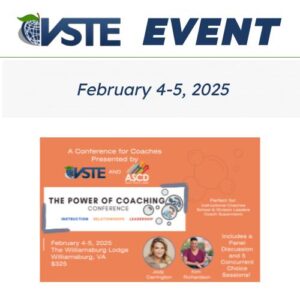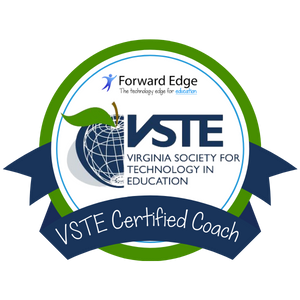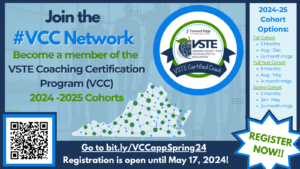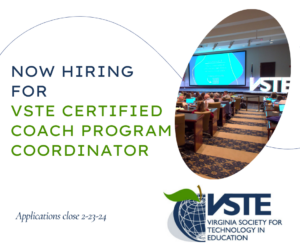As the year draws to a close it is fitting that we look back on the months and milestones that have made 2024 a year of significant growth and advancement for VSTE. The highlights from 2024 feature many of the ways that VSTE has advanced and grown as an organization. Communication, Membership, Development, and Partnership are the four goal areas identified in the 2024-2027 Strategic Plan. Guided by our 2024-2027 Strategic Plan, we achieved the following.
Communication
Communication as a goal primarily focuses on showcasing the identity of VSTE, focusing on its purpose, and recognizing ways to strengthen involvement through awareness. Our strategic plan emphasizes a clear purpose and intentional decision-making. Developing the strategic plan provided many opportunities for the Board to discuss the values and vision of the organization. The plan has helped to solidify our commitment to our core values and utilize our organizational strengths. Communication is critical to our success. There is more to follow regarding the Communication Plan and gaining insight from our membership. We have restructured our regular meetings to enhance communication and encourage dialogue among the Board. Weekly meetings with the executive director have also increased the flow of information and the opportunities for said dialogue.
Membership
Engaging and expanding our membership is the focus of the second strategic plan goal. The adoption of an association management system and the creation of a membership portal will lead the organization toward better understanding and interacting with its membership. The membership portal has enhanced member engagement by allowing members to manage their profiles and keep their information up-to-date. The membership portal has also allowed the organization to better keep track of the roles and locations of our members, including those that support the organization as exhibitors and sponsors. This will lead to more effective and efficient dialogue with members and allow VSTE to effectively know and better understand our membership. Through these efforts, we have been establishing a foundation for enhancing the benefits of membership. Every attendee at this year’s annual conference is an active VSTE member with an updated profile including all of our exhibitors and our sponsors.
Our annual conference builds on our reputation for providing an outstanding lineup of presenters and featured speakers. Our presenters allow us to celebrate the success of the finest educators in Virginia and bring perspectives from those recognized for their impact on the national teaching and learning community. The efforts of our conference team have been focused on continuing this legacy through the enhancement of the overall conference experience.
Development
Continued development is important to any organization. VSTE has continued to build on the certified coaching program and has also begun to shape and develop the professional services team. The certified coaching program has grown significantly, with over 300 certified coaches and over 100 more in training. The professional services program has begun to recruit talent and has taken on its first series of content creation and delivery which will roll out in early 2025. Both of these programs bring together a network of talented individuals to support the ongoing innovation that is a hallmark of VSTE. These networks will also help us to better identify the needs of our community and also the expert and experienced professionals to meet those needs.
Partnerships
Partnerships with other organizations stretches VSTE in positive ways as the collaborations extend the reach and influence of the organization. Our partnerships with key supporters are essential to our mission and vision. Maintaining ongoing partnerships and seeking out new partnerships provides both structure and new opportunities to serve our community. We are pleased to continue the work we have done with the Virginia Department of Education, Virtual Virginia, the Virginia Association for Supervision and Curriculum Development (VASCD), CodeVA, the Greater Richmond Area Educational Technology Consortium (GRAETC) and the Shenandoah Valley Educational Technology Collaborative (SVETC), Blue Ridge PBS, WHRO, Virginia Ed Strategies, Forward Edge, Virginia's Training and Technical Assistance Centers (T/TAC), the Commonwealth Partnership for Learning, as well as our many sponsors and exhibitors. We also continue our memberships with national organizations like the Consortium of School Networks (CoSN), the State Educational Technology Directors Association (SETDA) and the School, Health, Library Broadband Coalition (SHLB). We learned in 2024 that the merger of ASCD + ISTE will bring changes to the relationship we have with those organizations as ASCD + ISTE refine their partnership program. Continuing on with effective partnerships provides VSTE and its members with great possibilities in the future. An example of this type of collaboration can be heard and seen in season one of the ActiVAtED Podcast series and by subscribing to season two.
Strategic Planning
The recently adopted 2024-2027 Strategic Plan is one way the Board has focused on VSTE’s internal growth and development. We completed several necessary revisions to our guidance documents and standard operating procedures like the VSTE Webinar Protocols, Procedures, and Best Practices and the Finance Policy and Procedures documents. The development of a Communications Plan has helped us make improvements in the utilization of the VSTE Blog, VSTE newsletter and various social media platforms to keep our followers informed and engaged. Effective communication, emphasis on the value of membership, developing programs that respond to the changing needs of our community and engaging partners that can support our growth are the goal driven and strategic means by which VSTE can proudly enter into 2025 and toward our fortieth conference with pride in its past and hope for its future.
Be well, make good happen, and keep in touch.








